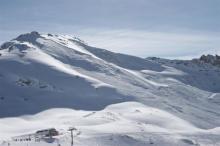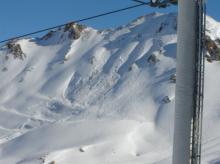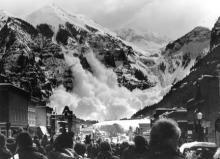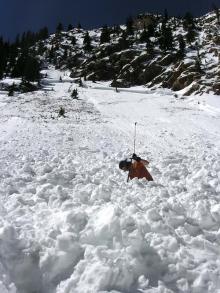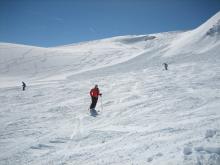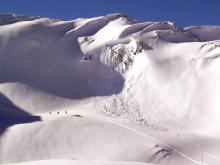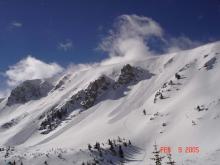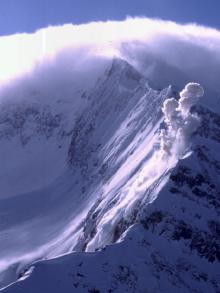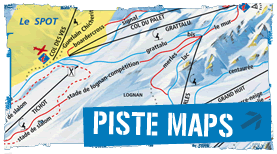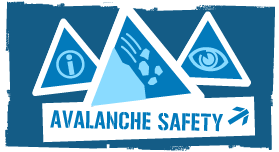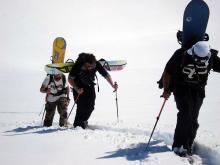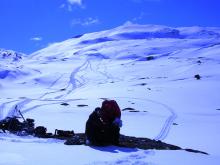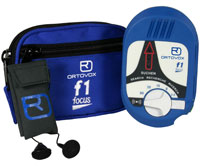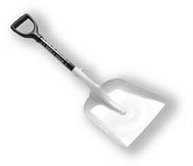Avalanche Awareness
Is it dangerous?
Slopes and snow conditions are stable, unstable or somewhere in between. Whether 'it is dangerous' or not depends on your judgement and decisions. You CAN be safe even when it is unstable - just as you can be in danger, or dangerous, when it is stable.
For training, information and guidance please take a look and contact www.henrysavalanchetalk.com
How dangerous the avalanche is will often depend on luck but also your knowledge, preparation and your equipment. If you need any avalanche equipment be sure to take a look at our store for all the latest kit.
In what way are the warning flags related to Avalanche risks?
Dotted around the slopes (usually where you get off a lift) you will see colour coded flags which are an indication of the avalanche risks on that day. These flags are just a guide, so even when there is a low risk, you could still be caught in an avalanche. These warning flags are however an extremely useful guide so take note! Have a look at the article in the In-Depth section that explains the Hazard Warnings in more detail.
What should I do if I'm caught in an avalanche?
Over the past decade, this is THE most frequently asked question.
Depending on the situation there are a number of things that you should try to do: First, once the snow starts moving, try to get off the snow that is breaking up as soon as possible. You can get out of an avalanche early if you are close to the fracture line or close to the edge (or flank) especially if the snow isn't too broken up. If you are close to one of these edges, do everything you can to move towards it. If the fracture line is just above you, try to allow the snow to move past you. For example, if you are on skis, side-step up, grab a tree, do whatever you possibly can. If the fracture line is way above you and you can't make it to the side fast, point your skis or snowboard downhill, say a prayer if you are so inclined, go like hell and try to get out of the way lower down.
There is a lot of controversy about what you should do if you are caught in the turning snow. First, see: 'What is it like to be caught in an avalanche?' below. Some say swim (since a person is about three times denser than moving avalanche debris) and others say roll. The most important thing is to keep your mouth free of snow especially when the snow comes to a stop; an air-pocket is essential to your survival in what amounts to a concrete tomb. It's almost impossible to dig yourself out of an avalanche. Most people suffocate within 15 minutes if they haven't actually been killed by the avalanche (approximately 10%). See the survival time chart. Before it stops, you can try pushing a hand upwards. Visual clues are the fastest way for rescuers to find you, but then, you may not be able to make an air-pocket.
For climbers... this whole scenario is horrific, especially when ice axes and people are attached to each other.
If I'm under the snow should I spit or pee to know which way is up?
A lot of people ask this question and the response is simply: "Who cares which way is up if you can't move!?". Even the lightest snow is extremely dense (heavy on top of you) once it reaches an avalanche deposition zone: 350-400 kg/m³. We know of very few people who have dug themselves out from under the debris of an avalanche. And we also know of a number of people who have suffocated to death with their head just a few centimetres below the surface. See survival time chart.
What kind of avalanche is most dangerous?
Dry slab avalanches account for almost all avalanche fatalities. In the northern hemisphere, these accidents happen in winter conditions (December to mid-March) and most often on north-facing slopes.
Can screaming and yelling start an avalanche?
We really don't think so. However if conditions are that unstable, why would you be screaming and yelling out there in the first place - unless it is for help. In our opinion, an increase in the volume of your individual and collective voices is inversely proportionate to the level of your awareness of potential hazards. Explosives that are used for avalanche control are powerful and it is the shock wave produced by the blast that sets off the avalanche.
Are avalanches an 'act of God'?
Avalanches are not easy to predict. Some avalanche paths are only active once every few hundred years; others are active in almost every storm. However, we can predict avalanches to a certain extent. To quote a well-known professional, Bruce Tremper, "they happen at particular times and in particular places for particular reasons". There are always observable signs of instability before an avalanche happens - recognised all too often after the fact: in 90% of all avalanche accidents, the avalanche trigger is the victim (or someone in the victim's party) and 90% of the time, a slab avalanche is involved.
Can I get out of the way of an avalanche?
Dry slab avalanches typically reach a speed of 90-130 km/h within about 5 seconds after they fracture. Avalanches that descend from above kill very few people. Wet avalanches usually travel much more slowly, around 30 km/h.
How can I begin to evaluate if the snow is stable or if it can fail?
LOOK AND LISTEN: you can understand a lot just by watching and listening.
LOOK: Recent avalanche activity is the most practical way to begin to evaluate the snowpack stability: if all of the east-facing slopes around you have evidence of recent avalanche activity and you are about to set out onto the only east facing slope that has not avalanched, this is clearly not a good idea.
LISTEN: When you hear and feel 'whoomphing', the snowpack is collapsing beneath you. The snowpack is telling you that it is unstable. If you are on a steep slope, it will be more than telling you, it will be releasing at the same time as the 'woomph'.
First thing in the morning after a snowstorm, snowpack stability is often uncertain. So, it's a good idea to start out on low-angle slopes - while constantly looking around to see if there are any consistent 'themes' in the recent avalanche activity (slope aspects, depth of slabs, steepness of slopes etc.) For example, if you notice that many northwest facing slopes have avalanched, this is a theme and a clue that there is significant instability on those slopes. Whether or not it is advisable to venture out onto those slopes depends on many other factors ranging from group dynamics and skill level to recent weather events, (e.g. rapid temperature fluctuations), steepness of slopes and the terrain below.
NEVER BASE EVALUATION OF STABILITY ON ONLY ONE CLUE!!!
Once I'm out there, how can I reduce the odds of getting caught in an avalanche?
At Henry's Avalanche Talk they call this 'Avalanche Etiquette'. Go one at a time on slopes that are questionable, have an escape route planned in your mind, stop at islands of safety and don't bury and kill people in the group below you. Windward slopes and especially ridges are the safest routes to travel on (but be careful of cornices - you can't see where they overhang when you are on top of them on the ridge!!). Thick trees are safer, but once the trees become sparse enough to get some good turns in, you are back in potential avalanche terrain. Finally, if things look really nasty, go back the way you came... if that is not also suspect.
Is the slope safe after an avalanche has gone?
Usually it's safe. But there are a number of things to watch out for: multiple avalanche starting zones ('hang fire') looming above, dense snowfall, hard wind. If there is rapid melting going on, then there's a good chance of another avalanche coming down. It's a hard call, especially if you are going to rescue someone.
How long can you live under the snow?
People die quickly from carbon dioxide poisoning because their carbon dioxide builds up in the snow around their mouths. Statistics show that about 90% of avalanche victims can be recovered alive if they are dug out within the first 5 minutes. However, after 45 minutes, only 20-30% are still alive - after two hours, almost no one is alive. See survival time chart.
I ski on the piste most of the time. Why should I go to an avalanche talk?
Since Henry has been living in the French Alps (about 13 years), most of the accidents and resulting deaths that he has witnessed have occurred right next to the piste, due to ignorance. They could therefore have been avoided. If you are a good skier or snowboarder who mostly skis on the piste and you play around next to the piste, then you are a prime candidate for an accident. The same goes for climbers: statistics show that the typical victim of an avalanche is a male in his mid-late 20's, has a good level of knowledge about skiing, boarding or climbing, but very little knowledge about avalanches.
See their Introduction Talks. - they've put them together for people like you.
How do they get caught?
In 90% of all avalanche incidents, the VICTIM, or someone in the victim's party, triggers the avalanche.
What is it like to be in an avalanche?
See Foxon's story, 'Chased by the Dragon' and others in Personal Accounts.
What causes slab avalanches to fracture?
Even though the answers to these last few questions are 'common knowledge' among professionals, Bruce Tremper provides the clearest explanations we know of. And so we often quote and paraphrase him:
"Snow is a lot like people. It doesn't like rapid change."
When people go through a lot of changes in a short amount of time, they can become very stressed and break up. Snow is the same - it needs time to adapt to change. Different types of people and different types of snowpacks have different tolerances to different types of change and stress. Dry slab avalanches occur when a relatively weak layer beneath the slab fractures, usually because too much additional weight has been added too quickly.
Snow is very sensitive to the rate at which it is loaded or stressed: a metre of snow added over two weeks is not a problem. A metre of snow in two days is a big problem. A metre of snow in 3 hours is a huge problem (wind can easily deposit a metre of snow in three hours). Finally, the weight of a person can add tremendous stress to a buried weak layer, not in 3 hours, but in two tenths of a second - an instantaneous change. That is why in 90% of all avalanche accidents, the avalanche trigger is the victim (or someone in the victim's party) and 90% of the time it is a slab avalanche that is involved. Wet slab avalanches occur for other reasons: percolating water dissolves the bonds between the snow grains, which decreases the strength of the ice 'skeleton' and adds lots of stress to a buried weak layer - if there is one.
What kind of weather produces avalanches?
Wind is the most common cause of acute instability. Wind can deposit snow 10 times faster than snow falling during storms. Wind erodes snow from the upwind side of obstacles and deposits snow on the downwind (lee) sides. We call this "wind loading".
The added weight from this "wind loading" also causes avalanches. If the weight of new snow is added faster than a buried weak layer can adjust to its load, then it fractures and forms an avalanche. Rapid warming can also cause dry avalanches but this is a much rarer occurrence.
Rain or melting of the snow surface can also cause avalanches. For instance, rain on new snow almost instantly causes avalanches. Strong sun or warm temperatures can also cause melting of the snow and creates wet avalanches. Large wet avalanches occur because of a decrease in strength of a buried weak layer as a result of water dissolving the bonds between the snow grains.
But wind, snow or rapid warming do not always produce avalanches. It depends on the condition of the pre-existing snow and the conditions during the storm. With very stable pre-existing snow, even heavy, new snow with wind can bond well and be perfectly safe in the right conditions.
How do I judge if a slope is 'dangerous'?
Here are a few things that you should look for systematically each time you go out onto a slope (this list is not exhaustive, but it covers the essentials!):
STEEPNESS: Almost all avalanches occur on slopes between 35 and 45 degrees. An 'expert' slope at a ski resort is usually around 35 degrees maximum.
ANCHORS: Trees and rocks that stick up through the snowpack can help to hold the snowpack in place. But the anchors need to be fairly thick to be effective. For instance a thick, mature grove of evergreen trees anchor the slab quite effectively while a sparse grove of trees has very little effect.
ASPECT WITH RESPECT TO WIND: Recently wind-loaded, steep slopes are almost always very dangerous while recently wind-eroded slopes are usually fairly safe.
Isn't it most dangerous in springtime when there are more avalanches?
Spring conditions may be the time of year when there are the most avalanches, but once a regular cycle of melting and freezing sets in, predicting the stability of the snowpack is more evident than during the cold winter months. During the freeze phase, the snowpack is at its strongest. Once free water has seeped into the snowpack, through rain or melting, then it can turn into ice when the temperatures go below freezing - the ice forms a sort of 'skeleton' that holds the snowpack together. Melting during the day and freezing at night is a classic springtime process. In these conditions, after a good freeze at night, the slopes are very stable first thing in the morning. Then, as the sun rises (warming east facing slopes first), the ice skeleton holding the snowpack together melts and the slope eventually becomes much less stable.
In melting and freezing conditions, the snowpack is at its strongest during the freeze phase then at its weakest during the melt phase. In between these phases, the skiing conditions can be tremendous as long as people haven't been there too late the day before. Get on the slope as the first few centimetres are beginning to melt and then get off. When melting penetrates more than 5 cm then the slope has started to become unstable and you will start to break through the crust - this alone can lead to injury. Making the right calls in these conditions takes experience - but that is part of the adventure!
For more information and guidance please spend time to look at www.henrysavalanchetalk.com
If you need any avalanche equipment be sure to take a look at our store for all the latest kit.


